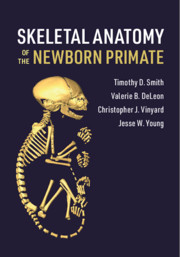Book contents
- Skeletal Anatomy of the Newborn Primate
- Skeletal Anatomy of the Newborn Primate
- Copyright page
- Contents
- Foreword
- Preface
- 1 Introduction
- 2 Primate Development and Growth
- 3 Why Ontogeny Matters
- 4 The Skull
- 5 Dentition
- 6 The Postcranial Axial Skeleton
- 7 The Pectoral Girdle and Forelimb Skeleton
- 8 The Pelvic Girdle and Hindlimb Skeleton
- 9 The Newborn Primate Body Form: Phylogenetic and Life-History Influences
- 10 Ontogeny of Feeding
- 11 Ontogeny of Locomotion
- References
- Index
- Atlas
11 - Ontogeny of Locomotion
Published online by Cambridge University Press: 23 March 2020
- Skeletal Anatomy of the Newborn Primate
- Skeletal Anatomy of the Newborn Primate
- Copyright page
- Contents
- Foreword
- Preface
- 1 Introduction
- 2 Primate Development and Growth
- 3 Why Ontogeny Matters
- 4 The Skull
- 5 Dentition
- 6 The Postcranial Axial Skeleton
- 7 The Pectoral Girdle and Forelimb Skeleton
- 8 The Pelvic Girdle and Hindlimb Skeleton
- 9 The Newborn Primate Body Form: Phylogenetic and Life-History Influences
- 10 Ontogeny of Feeding
- 11 Ontogeny of Locomotion
- References
- Index
- Atlas
Summary
Primate locomotor development is a protracted process. We summarize the time course of locomotor development in approximately 50 primates distributed across the extant radiation. Despite substantial variance, we identify several broad trends. Primates are somewhat precocial at birth – born with their eyes open and able to strongly grasp. Locomotor onset age generally increases with body mass, although certain taxonomic groups (e.g., lemurids and cercopithecids) develop early for their size whereas others (e.g., indriids and hominids) develop relatively late. Initial locomotor movements are similar across primates and dominated by quadrupedal crawling. Only later do more specialized forms of locomotion emerge (e.g., leaping and brachiation), often in concert with functional changes in musculoskeletal anatomy (e.g., maturation of intermembral indices, center of mass position, and bony muscle leverage). We advocate viewing locomotor development as a fundamental life-history parameter, responding to the same evolutionary pressures shown to be fundamental to other aspects of primate life history (e.g., predation, resource access, body size, encephalization).
Keywords
- Type
- Chapter
- Information
- Skeletal Anatomy of the Newborn Primate , pp. 249 - 273Publisher: Cambridge University PressPrint publication year: 2020



